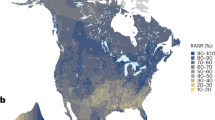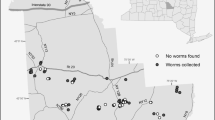Abstract
Earthworm introductions and invasions are ongoing, with significant consequences for ecological characteristics and function where populations of invasive species reach high densities. In North America the influx of people, goods and materials to coastal cities has long been recognized to be related to introduction and establishment of many different invasive organisms. We conducted surveys for soil invertebrates in the Washington, DC area along the Potomac River corridor to examine the influence of historic soil profile disrupting disturbances on the composition of soil invertebrate communities. Here we report three earthworm taxa that either (1) had never been previously reported in North America (Lumbricidae: Helodrilus oculatus), (2) had never been reported from “wild” caught samples in forested soils (Lumbricidae: Eisenia fetida), or (3) represented a notable range expansion for an introduced species (Lumbricidae: Murchieona muldali). All three species reported here have attributes that give reason for concern over their expansion into North American soils, not least of which is their potential for competitive interactions with the remaining native earthworm species.
Similar content being viewed by others
References
Blakemore RJ (2012) On Schmarda’s lost earthworm and some newly found New Zealand species (Oligochaeta: megadrilacea: Lumbricidae, Acanthodrilidae, Octochaetidae, and Megascolecidae s. stricto). J Species Res 1:105–132
Callaham MA Jr, González G, Hale CM, Heneghan L, Lachnicht SL, Zou X (2006) Policy and management responses to earthworm invasions in North America. Biol Inv 8:1317–1329
Cameron EK, Bayne EM (2009) Road age and its importance in earthworm invasion of northern boreal forests. J Appl Ecol 46:28–36
Clasuen MW (1987) Earthworms (Lumbricidae) new to Denmark. Flora og Fauna 93:39–43
Eisen (1900) Researches in American Oligochaeta PCAS 3ed (see Fragoso)
Eisenhauer N, Partsch S, Parkinson S, Scheu S (2007) Invasion of a deciduous forest by earthworms: changes in soil chemistry, microflora, microarthropods and vegetation. Soil Biol Biochem 39:1099–1110
Fragoso C, James SW, Borges S (1995) Native earthworms of the North Neotropical region: current status and controversies. In: Hendrix PF (ed) Earthworm ecology and biogeography in North America. CRC Press, Boca Raton, pp 67–115
Frelich LE, Hale CM, Scheu S, Holdsworth AR, Heneghan L, Bohlen PJ, Reich PB (2006) Earthworm invasion into previously earthworm-free temperate and boreal forests. Biol Inv 8:1235–1245
Gates GE (1972) Burmese earthworms. An introduction to the systematics and biology of Megadrile Oligochaetes with special reference to Southeast Asia. Trans Am Philos Soc 62:1–326
Greiner HG, Kashian DR, Tiegs SD (2012) Impacts of invasive Asian (Amynthas hilgendorfi) and European (Lumbricus rubellus) earthworms in a North American temperate deciduous forest. Biol Inv 10:2017–2027
Hendrix PF, Baker GH, Callaham MA Jr, Damoff GA, Fragoso C, González G, James SW, Lachnicht SL, Winsome T, Zou X (2006) Invasion of exotic earthworms into ecosystems inhabited by native earthworms. Biol Inv 8:1287–1300
Hendrix PF, Callaham MA Jr, Drake J, Huang C-Y, James SW, Snyder BA, Zhang W (2008) Pandora’s box contained bait: the global problem of introduced earthworms. Annu Rev Ecol Evol Syst 29:571–592
Holdsworth AR, Frelich LE, Reich PB (2007) Regional extent of an ecosystem engineer: earthworm invasion in northern hardwood. Ecol Appl 17:1666–1677
Kalisz PJ, Dotson DB (1989) Land-use history and the occurrence of exotic earthworms in the mountains of Eastern Kentucky. Am Midl Nat 122:288–297
Mann CC (2007) Legacy of Jamestown: America. Found and lost. Natl Geogr 211(5):32–55
Marichal R, Martinez AF, Praxedes C, Ruiz D, Carvajal AF, Oszwald J, Hurtado MdP, Brown GG, Grimaldi M, Desjardins T, Sarrazin M, Decaëns T, Velasquez E, Lavelle P (2009) Invasion of Pontoscolex corethrurus (Glossoscolecidae, Oligochaeta) in landscapes of the Amazonian deforestation arc. Appl Soil Ecol 46:443–449
McLean MA, Parkinson D (2000) Field evidence of the effects of the epigeic earthworm Dendrobaena octaedra on the microfungal community in pine forest floor. Soil Biol Biochem 32:351–360
Reynolds JW, Wetzel MJ (2011) The earthworms (Oligochaeta: acanthodrilidae, Glossoscolecidae, Komarekionidae, Lumbricidae, Megascolecidae, and Sparganophilidae) of Illinois, USA. Megadrilogica 15:35–67
Sims RW, Gerard BM (1985) Earthworms. Linnean society of London. Pitman Press, Bath
Snyder BA, Callaham MA Jr, Hendrix PF (2011) Spatial variability of an invasive earthworm (Amynthas agrestis) population and potential impacts on soil characteristics and millipedes in the Great Smoky Mountains National Park, USA. Biol Inv 13:349–358
Snyder BA, Callaham MA Jr, Lowe CN, Hendrix PF (2013) Earthworm invasion in North America: food resource competition affects native millipede survival and invasive earthworm reproduction. Soil Biol Biochem 57:212–216
Stebbings JH (1962) Endemic-exotic earthworm completion in the American Midwest. Nature 196:905–906
Szederjesi T, Angyal D, Balázs G, Dányi L (2014) Remarks on the earthworm genus Helodrilus Hoffmeister, 1845 with new epigean and subterranean records (Oligochaeta, Lumbricidae). Opusc Zool Budapest 45:181–188
Tiunov AV, Hale CM, Holdsworth AR, Vsevolodova-Perel TS (2006) Invasion patterns of Lumbricidae into the previously earthworm-free areas of Northeastern Europe and the Western Great Lakes region of North America. Biol Inv 8:1223–1234
Author information
Authors and Affiliations
Corresponding author
Rights and permissions
About this article
Cite this article
Callaham, M.A., Snyder, B.A., James, S.W. et al. Evidence for ongoing introduction of non-native earthworms in the Washington, DC metropolitan area. Biol Invasions 18, 3133–3136 (2016). https://doi.org/10.1007/s10530-016-1230-2
Received:
Accepted:
Published:
Issue Date:
DOI: https://doi.org/10.1007/s10530-016-1230-2




